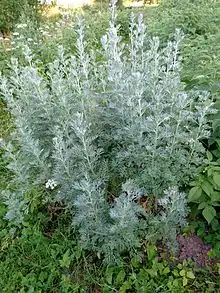Artemisia (plant)
Artemisia (/ˌɑːrtɪˈmiːziə/)[3] is a large, diverse genus of plants belonging to the daisy family Asteraceae, with between 200 and 400 species. Common names for various species in the genus include mugwort, wormwood, and sagebrush.
| Artemisia | |
|---|---|
 | |
| Artemisia cina (Levant wormseed)[1] | |
| Scientific classification | |
| Kingdom: | Plantae |
| Clade: | Tracheophytes |
| Clade: | Angiosperms |
| Clade: | Eudicots |
| Clade: | Asterids |
| Order: | Asterales |
| Family: | Asteraceae |
| Subfamily: | Asteroideae |
| Tribe: | Anthemideae |
| Genus: | Artemisia L. |
| Type species | |
| Artemisia vulgaris L. | |
| Synonyms[2] | |
| |
Artemisia comprises hardy herbaceous plants and shrubs, which are known for the powerful chemical constituents in their essential oils. Artemisia species grow in temperate climates of both hemispheres, usually in dry or semiarid habitats. Notable species include A. vulgaris (common mugwort), A. tridentata (big sagebrush), A. annua (sagewort), A. absinthium (wormwood), A. dracunculus (tarragon), and A. abrotanum (southernwood). The leaves of many species are covered with white hairs.
Most species have strong aromas and bitter tastes from terpenoids and sesquiterpene lactones, which discourage herbivory, and may have had a selective advantage.[4] The small flowers are wind-pollinated.[4] Artemisia species are used as food plants by the larvae of a number of Lepidoptera species.
Some botanists split the genus into several genera, but DNA analysis[5] does not support the maintenance of the genera Crossostephium, Filifolium, Neopallasia, Seriphidium, and Sphaeromeria; three other segregate genera — Stilnolepis, Elachanthemum, and Kaschgaria — are maintained by this evidence. Occasionally, some of the species are called sages, causing confusion with the Salvia sages in the family Lamiaceae.
Taxonomy
The genus was erected by Carl Linnaeus in 1753. The name Artemisia derives from the Greek goddess Artemis (Roman Diana), the namesake of Greek Queens Artemisia I and II.[6] A more specific reference may be to Artemisia II of Caria, a botanist and medical researcher (also a queen and naval commander), who died in 350 BC.[7][8]
Selected species
As of November 2020, Plants of the World Online accepted almost 470 species, including:[9]
- Artemisia abrotanum L. – southernwood, southern wormwood, slovenwood, abrotanum, old-man, lad's love
- Artemisia absinthium L. – grand wormwood, absinthium
- Artemisia adamsii Besser
- Artemisia afra Jacq. ex Willd. – African wormwood, African sagebrush
- Artemisia alaskana Rydb. – Alaska wormwood; synonym of Artemisia kruhsiana subsp. alaskana
- Artemisia alba Turra – camphor southernwood
- Artemisia aleutica Hultén – Aleutian wormwood
- Artemisia amoena Poljakov
- Artemisia annua L. – annual wormwood, sweet sagewort, sweet Annie
- Artemisia araxina Takht.
- Artemisia arborescens L. – tree wormwood
- Artemisia arbuscula Nutt. – little sagebrush, low Sagebrush, black sage
- Artemisia arctisibirica Korobkov
- Artemisia arenaria DC.
- Artemisia arenicola Krasch. ex Poljakov
- Artemisia argentea L'Hér. – Madeira wormwood
- Artemisia argyi H.Lév. & Vaniot – Chinese mugwort
- Artemisia argyrophylla Ledeb.
- Artemisia armeniaca Lam.
- Artemisia australis Less. – ʻĀhinahina, Oʻahu wormwood[10]
- Artemisia austriaca Jacq.
- Artemisia avarica Minat.
- Artemisia balchanorum Krasch.
- Artemisia baldshuanica Krasch. & Zaprjag.
- Artemisia bargusinensis Spreng.
- Artemisia bejdemaniae Leonova
- Artemisia bhutanica Grierson & Spring.
- Artemisia biennis Willd. – biennial sagewort, biennial wormwood
- Artemisia bigelovii A.Gray – Bigelow sage, Bigelow sagebrush
- Artemisia borealis Pall.
- Artemisia borotalensis Poljakov
- Artemisia caerulescens L.
- Artemisia caespitosa Ledeb.
- Artemisia californica Less. – coastal sagebrush, California sagebrush
- Artemisia campestris L. – field wormwood, sand wormwood
- Artemisia cana Pursh – silver sagebrush
- Artemisia capillaris Thunb. – capillary wormwood, yin-chen wormwood
- Artemisia carruthii Wood ex Carruth. – Carruth sagewort, Carruth's sagebrush
- Artemisia chamaemelifolia Vill.
- Artemisia cina O.Berg & C.F.Schmidt – santonica, Levant wormseed
- Artemisia ciniformis Krasch. & Popov ex Poljakov
- Artemisia compacta Fisch. ex DC.
- Artemisia cuspidata Krasch.
- Artemisia czukavinae Filatova
- Artemisia daghestanica Krasch. & Poretzky
- Artemisia demissa Krasch.
- Artemisia deserti Krasch.
- Artemisia desertorum Spreng.
- Artemisia diffusa Krasch. ex Poljakov
- Artemisia dimoana Popov
- Artemisia dolosa Krasch.
- Artemisia douglasiana Bess. – Douglas' mugwort, Douglas' sagewort, northwest mugwort
- Artemisia dracunculus L. – tarragon, silky wormwood
- Artemisia dubia Wall.
- Artemisia dubjanskyana Krasch. ex Poljakov
- Artemisia dumosa Poljakov
- Artemisia elongata Filatova & Ladygina
- Artemisia eremophila Krasch. & Butkov ex Poljakov
- Artemisia fedtschenkoana Krasch.
- Artemisia ferganensis Krasch. ex Poljakov
- Artemisia filifolia Torr. – sand sagebrush, sand-sage, silvery wormwood
- Artemisia franserioides Greene – ragweed sagebrush
- Artemisia freyniana (Pamp.) Krasch.
- Artemisia frigida Willd. – fringed sagebrush, fringed-sage, prairie sagewort, estafiata
- Artemisia fulvella Filatova & Ladygina
- Artemisia furcata Bieb. – forked wormwood
- Artemisia galinae Ikonn.
- Artemisia genipi Weber ex Stechm.
- Artemisia glacialis L. – glacier wormwood, alpine mugwort
- Artemisia glanduligera Krasch. ex Poljakov
- Artemisia glauca Pall. ex Willd.
- Artemisia glaucina Krasch. ex Poljakov
- Artemisia globosa Krasch.
- Artemisia globularia Cham. ex Bess. – purple wormwood
- Artemisia glomerata Ledeb. – cudweed sagewort, Pacific alpine wormwood
- Artemisia gmelinii Webb ex Stechmann – Gmelin's wormwood, Russian wormwood
- Artemisia gorgonum Webb
- Artemisia gracilescens Krasch. & Iljin
- Artemisia granatensis Boiss. ex DC.
- Artemisia gurganica (Krasch.) Filatova
- Artemisia gypsacea Krasch., Popov & Lincz. ex Poljakov
- Artemisia halodendron Turcz. ex Besser
- Artemisia heptapotamica Poljakov
- Artemisia herba-alba Asso – white wormwood
- Artemisia hippolyti Butkov
- Artemisia hololeuca M.Bieb. ex Besser
- Artemisia incana (L.) Druce
- Artemisia indica Willd. – Indian wormwood
- Artemisia insularis Kitam.
- Artemisia integrifolia L.
- Artemisia issykkulensis Poljakov
- Artemisia jacutica Drobow
- Artemisia japonica Thunb. – otoko yomogi
- Artemisia judaica L.
- Artemisia juncea Kar. & Kir.
- Artemisia karatavica Krasch. & Abolin ex Poljakov
- Artemisia karavajevii Leonova
- Artemisia kaschgarica Krasch.
- Artemisia kauaiensis (Skottsberg) Skottsberg – ʻĀhinahina, Kauaʻi wormwood
- Artemisia keiskeana Miq.
- Artemisia knorringiana Krasch.
- Artemisia kochiiformis Krasch. & Lincz. ex Poljakov
- Artemisia koidzumii Nakai
- Artemisia kopetdaghensis Krasch. ex Poljakov
- Artemisia korovinii Poljakov
- Artemisia korshinskyi Krasch. ex Poljakov
- Artemisia kuschakewiczii C.G.A.Winkl.
- Artemisia laciniata Willd. – Siberian wormwood
- Artemisia lactiflora Wall. ex DC. – white mugwort
- Artemisia lagocephala (Besser) DC.
- Artemisia lagopus Fisch. ex Besser
- Artemisia latifolia Ledeb.
- Artemisia ledebouriana Besser
- Artemisia lehmanniana Bunge
- Artemisia lessingiana Besser
- Artemisia leucodes Schrenk
- Artemisia leucophylla (Turcz. ex Besser) Pamp.
- Artemisia leucotricha Krasch. ex Ladygina
- Artemisia lipskyi Poljakov
- Artemisia littoricola Kitam.
- Artemisia longifolia Nutt. – longleaf sagebrush, longleaf wormwood
- Artemisia ludoviciana Nutt. – gray sagewort, prairie sage, white sagebrush, Louisiana-sage, western-sage
- Artemisia macilenta (Maxim.) Krasch.
- Artemisia macrantha Ledeb.
- Artemisia macrocephala Jacq. ex Besser
- Artemisia macrorhiza Turcz.
- Artemisia maritima L. – sea wormwood, absinthe de mer
- Artemisia marschalliana Spreng.
- Artemisia mauiensis (A.Gray) Skottsberg – ʻĀhinahina, Maui wormwood
- Artemisia maximovicziana Krasch. ex Poljakov
- Artemisia medioxima Krasch. ex Poljakov
- Artemisia michauxiana Bess. – Michaux sagebrush, Michaux's wormwood, lemon sagewort
- Artemisia minor Jacq. ex Besser
- Artemisia mogoltavica Poljakov
- Artemisia mongolica (Besser) Fisch. ex Nakai
- Artemisia mongolorum Krasch.
- Artemisia montana (Nakai) Pamp.
- Artemisia mucronulata Poljakov
- Artemisia nakaii Pamp.
- Artemisia namanganica Poljakov
- Artemisia negrei Ouyahya
- Artemisia nesiotica Raven – island sagebrush
- Artemisia nigricans Filatova & Ladygina
- Artemisia niitakayamensis Hayata
- Artemisia nilagirica (C.B.Clarke) Pamp.
- Artemisia nitida Bertol.
- Artemisia nortonii Pamp.
- Artemisia norvegica Fr. – Norwegian mugwort, alpine sagewort
- Artemisia nova A.Nels. – black sagebrush, small sagebrush
- Artemisia obtusiloba Ledeb.
- Artemisia occidentalisichuanensis Y.R.Ling & S.Y.Zhao
- Artemisia occidentalisinensis Y.R.Ling
- Artemisia oelandica (Besser) Krasch.
- Artemisia olchonensis Leonova
- Artemisia oliveriana J.Gay ex Besser
- Artemisia ordosica Krasch.
- Artemisia orientalixizangensis Y.R.Ling & Humphries
- Artemisia orientaliyunnanensis Y.R.Ling
- Artemisia packardiae J.Grimes & Ertter – Packard's wormwood, Succor Creek sagebrush
- Artemisia palmeri A.Gray – San Diego sagewort
- Artemisia palustris L.
- Artemisia pallens Wall
- Artemisia pannosa Krasch.
- Artemisia papposa S.F.Blake & Cronq. – Owyhee sage, Owyhee sagebrush
- Artemisia pattersonii A.Gray – Patterson's wormwood
- Artemisia pedatifida Nutt. – birdfoot sagebrush, matted sagewort
- Artemisia pedemontana Balb.
- Artemisia persica Boiss.
- Artemisia phaeolepis Krasch.
- Artemisia pontica L. – Roman wormwood, green-ginger
- Artemisia porrecta Krasch. ex Poljakov
- Artemisia porteri Cronq. – Porter's wormwood, Porter mugwort
- Artemisia princeps Pamp. – Japanese mugwort, yomogi
- Artemisia prolixa Krasch. ex Poljak.
- Artemisia punctigera Krasch. ex Poljakov
- Artemisia pycnocephala (Less.) DC. – beach wormwood, coastal sagewort
- Artemisia pygmaea A.Gray – pygmy sagebrush
- Artemisia quinqueloba Trautv.
- Artemisia remotiloba Krasch. ex Poljakov
- Artemisia rhodantha Rupr.
- Artemisia rigida (Nutt.) A.Gray – scabland sagebrush
- Artemisia rothrockii A.Gray – timberline sagebrush
- Artemisia roxburghiana Wall. ex Besser
- Artemisia rubripes Nakai
- Artemisia rupestris L. – rock wormwood
- Artemisia rutifolia Stephan ex Spreng.
- Artemisia saissanica (Krasch.) Filatova
- Artemisia saitoana Kitam.
- Artemisia salsoloides Willd.
- Artemisia samoiedorum Pamp.
- Artemisia saposhnikovii Krasch. ex Poljak.
- Artemisia schmidtiana Maxim. – angel's hair
- Artemisia schrenkiana Ledeb.
- Artemisia scoparia Waldst. & Kit. – redstem wormwood, yin-chen wormwood
- Artemisia scopiformis Ledeb.
- Artemisia scopulorum A.Gray – alpine sagebrush, dwarf sagebrush
- Artemisia scotina Nevski
- Artemisia semiarida (Krasch. & Lavrenko) Filatova
- Artemisia senjavinensis Bess. – arctic wormwood
- Artemisia sericea Weber ex Stechm.
- Artemisia serrata Nutt. – sawtooth wormwood
- Artemisia sieberi Besser
- Artemisia sieversiana Willd. – sieversian wormwood
- Artemisia spiciformis K.Koch
- Artemisia spicigera K.Koch
- Artemisia spinescens D.C.Eaton – budsage [syn. Picrothamnus desertorum]
- Artemisia splendens Willd.
- Artemisia stelleriana Bess. – hoary mugwort, oldwoman, Dusty Miller, beach wormwood
- Artemisia stenocephala Krasch. ex Poljak.
- Artemisia subarctica Krasch.
- Artemisia subchrysolepis Filatova
- Artemisia sublessingiana Krasch. ex Poljakov
- Artemisia subsalsa Filatova
- Artemisia succulenta Ledeb.
- Artemisia suksdorfii Piper – coastal wormwood, Suksdorf sagewort
- Artemisia sylvatica Maxim.
- Artemisia tanacetifolia L.
- Artemisia taurica Willd. – Tauric wormwood
- Artemisia tenuisecta Nevski
- Artemisia terrae-albae Krasch.
- Artemisia thuscula Cav.
- Artemisia tianschanica Krasch. ex Poljak.
- Artemisia tilesii Ledeb. – Tilesius' wormwood, Aleutian mugwort
- Artemisia tomentella Trautv.
- Artemisia transbaicalensis Leonova
- Artemisia transiliensis Poljakov
- Artemisia trautvetteriana Besser
- Artemisia tridentata Nutt. – big sagebrush, blue sage, black sage, basin sagebrush, common sagebrush
- Artemisia tripartita Rydb. – threetip sagebrush
- Artemisia turanica Krasch.
- Artemisia turcomanica Gand.
- Artemisia umbelliformis Lam. – Alps wormwood, alpine wormwood
- Artemisia vachanica Krasch. ex Poljak.
- Artemisia valida Krasch. ex Poljak.
- Artemisia verlotiorum Lamotte – Chinese wormwood
- Artemisia vulgaris L. – mugwort, felonherb, green-ginger, common wormwood
- Artemisia waltonii J.R.Drumm. ex Pamp.
- Artemisia wudanica Liou & W.Wang
- Artemisia xerophytica Krasch.
- Artemisia yadongensis Ling & Y.R.Ling
- Artemisia yongii Y.R.Ling
- Artemisia younghusbandii J.R.Drumm. ex Pamp.
- Artemisia zayuensis Y.R.Ling
- Artemisia zhongdianensis Y.R.Ling
Formerly placed here
- Centipeda minima (L.) A.Braun & Asch. (as A. minima L.)
- Eupatorium capillifolium (Lam.) Small (as A. capillifolia Lam.)
- Filifolium sibiricum (L.) Kitam. (as A. sibirica (L.) Maxim.)
- Grangea maderaspatana (L.) Poir. (as A. maderaspatana L.)
- Matricaria discoidea DC. (as A. matricarioides auct.)[11]
Classification
Classification of Artemisia is difficult.[4] Divisions of Artemisia prior to 2000 into subgenera or sections have not been backed up by molecular data,[5] but much of the molecular data, as of 2006, are not especially strong.[4] The following identified groups do not include all the species in the genus.
Subgenera Artemisia and Absinthium
Subgenera Artemisia and Absinthium are sometimes, but not always, considered the same. Subgenus Artemisia (originally Abrotanum Besser) is characterized by a heterogamous flower head with female outer florets and hermaphrodite central florets, and a fertile, glabrous receptacle. Absinthium DC, though sometimes merged with subgenus Artemisia is characterized by heterogamous flower head with female outer florets and hermaphrodite central florets, and a fertile, hairy receptacle. Generally, previously proposed monotypic and non-monophyletic subgenera have been merged with the subgenus Artemesia due to molecular evidence. For example, in 2011 using ribosomal DNA analysis of their own and a review of molecular data (such as ITS sequence analysis) of others, S. Garcia and colleagues argued that it was logical to rename several Sphaeromeria and Picrothamnus (formerly designated sister genera to Artemisia) species as Artemisia, as well as to revert some Sphaeromeria species back to Artemisia, where they had been categorized previously.[12] Part of this was due to research by Watson and colleagues, who found that the four subgenera were not monophyletic except for Dracunculus, after analyzing and matching the internal transcribed spacers of nuclear ribosomal DNA from many Seriphidium and Artemisia species, and the related genera Arctanthemum and Dendranthema. The authors concluded that inflorescence morphology is not alone reliable for categorizing the genus or some subgenera, as qualities that previously demarcated them (such as homogamous, discoid, ray-less inflorescences) seemed to have undergone paralleled evolution up to seven times.[5] Picrothamnus Nutt. (“bud sage”), now considered Artemisia spinescens and Sphaeromeria Nutt. (“chicken sage”) are some examples, both endemic to North America.[12]
Tridentatae
Section Tridentatae consists of eleven to thirteen species of coarse shrubs often known colloquially as "sagebrushes", which are very prominent parts of the flora in western North America.[13] In some classifications, they have previously been considered part of the genus or subgenus Seriphidium, although recent studies have contested this lineage to Old World species.[5] Tridentatae was first articulated as a section by Rydberg in 1916, and it was not until McArthur et al. in 1981 that Tridentatae was elevated to a separate subgenus from Seriphidium. The principal motive for their separation was geographical distribution, chemical makeup, and karyotype.[14] Much of the debate surrounding Tridentatae is phytogeographic, thus habitat and geography are frequently cited when understanding the evolution of this endemic North American subgenus. Evolutionary cycles of wet and dry climates encouraged “diploid and polyploid races which are morphologically similar if not indistinguishable” (McArthur 598).
Autopolyploidy among plants is not uncommon, however Tridentatae exhibits a remarkable amount of chromosomal differences at the population level, rather than the taxon level. This contributes to the difficulty in determining Tridentatae's phylogeny. The subgenus’ relative homogeneity within ploidies has enabled it to habitually hybridize and backcross, resulting in a high degree of genetic variation at the population level rather than the taxon level.[15] For instance, some articles suggest that to be monophyletic, section Tridentatae should exclude Artemisia bigelovii and Artemisia palmeri.[5][13] and include Artemisia pygmaea and Artemisia rigida.[16] These results were supported by extensive chloroplast DNA (cpDNA) and nrDNA sequencing which departed from prior morphological, anatomical, and behavioral data.
Traditional lineages within Tridentatae were proposed on the basis of leaf morphology, habitat preference, and the ability to leaf-sprout, among other morphological and behavioral characteristics.[13] For instance, sagebrush in the Artemisia tridentata lineage have tridentate leaves, live in especially arid habitats, and are unable to root-sprout.[13] This method of delimitation is problematic for species that do not fully adhere to the characteristics of a given lineage. The dry habitat and the presence of interxylary cork has often made the case for Tridentatae as a subgenus of its own,[17] and there is some ribosomal molecular evidence of a “Tridentatae core” group for the subgenus.[18] In 2011, Garcia and colleagues proposed enlarging Tridentatae and organized it into the sections Tridentatae, Nebulosae, and Filifoliae based on previous research establishing relationships via ribosomal and nuclear DNA.[19][12]
Intergrading forms are particularly common in recently radiated subgenera such as Tridentatae, given their frequent reversals and convergent evolution. Global reviews of Artemisia using ITS analysis support the hypothesis that Tridentatae has independent origins from Old World Seriphidium[5] These findings were compared with capitula morphology, challenging past assumptions based on floral characteristics. To better understand the rapid diversification and radiation relative to Old World Artemisia, a closer study of Beriginian or Arctic species may provide missing links.[20]
Section Tridentatae includes above species with exception of Artemisia longiloba, which is treated as a subspecies of Artemisia arbuscula. Section Nebulae includes Artemisia californica, Artemisia nesiotica, and Artemisia filifolia.[21]
Seriphidium
The Old World species which different classifications put into the genus or subgenus Seriphidium consist of about 125 species native to Europe and temperate Asia, with the largest number of species in Central Asia.[22] Some classifications, such as that of the Flora of North America, exclude any New World plants from Seriphidium.[4] They are herbaceous plants or small shrubs.[22]
Seriphidium Besser was morphologically categorized by a homogamous flower head with all hermaphrodite florets and fertile and glabrous receptacle. Tridentatae was originally categorized as within Seriphidium due to floral, inflorescence, and leaf morphological similarities, until McArthur et al.’s analysis in 1981, which explained these similarities as convergent evolution.[23] Old World Seriphidium, with 125 species native to Europe and temperate Asia, was a previous classification of Seriphidium. North American or "New World" Seriphidium and Old World Seriphidium. North American Seriphidium were later placed into Tridentatae Rydb due to geographical distribution, growth habit, and karyotypic and chemotaxonomic similarities (such as presence of certain terpenols).[24]
Subgenus Dracunculus
One group which is well-supported by molecular data is subgenus Dracunculus. It consists of 80 species found in both North America and Eurasia,[4] of which the best-known is perhaps Artemisia dracunculus, the spice tarragon.
Dracunculus Besser. has historically been characterized morphologically by a heterogamous flower head with female outer florets and hermaphrodite central florets, but with a female-sterile, glabrous receptacle. Dracunculus is the most supported and resolved subgenus of Artemisia, which includes Artemisia dracunculus L., known as the cooking spice tarragon. Chloroplast and ribosomal DNA sequence analysis in 2011 supported monophyly with two clades, one of which includes some North American endemic species as well as most species of Europe and Asia, while the second clade includes just A. salsoloides and A. Tanaitica, found in Eastern Europe and Siberia to the Western Himalayas.[25] This study places Dracunculus as one of the more recent subgenera within Artemisia, situating A. Salisoides more basally on the tree, with North American endemic groups such as the sagebrushes having derived on the other end of a split from a common ancestor with Dracunculus. Formerly proposed genera Mausolea, Neopallasia and Turaniphytum are now argued to be within the subgenus Dracunculus due to ribosomal and chloroplast DNA evidence, with further species resolved as sister groups to Dracunculus due to phytochemical relationships.[25][26]
Cultivation and uses
The aromatic leaves of some species are used for flavouring. Most species have an extremely bitter taste. A. dracunculus (tarragon) is widely used as a culinary herb, particularly important in French cuisine.
Artemisia vulgaris (mugwort) was used to repel midges (mug > midge), fleas and moths, intestinal worms, and in brewing (mugwort beer, mugwort wine) as a remedy against hangovers and nightmares.
Artemisia absinthium is used to make the highly potent spirit absinthe. Malört also contains wormwood. The aperitif vermouth (derived from the German word Wermut, "wormwood") is a wine flavored with aromatic herbs, but originally with wormwood.
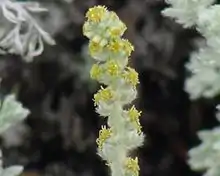
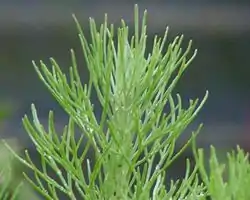
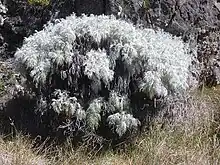
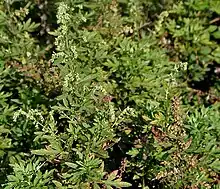
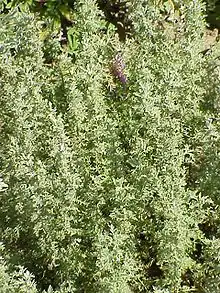
Artemisia arborescens (tree wormwood, or sheeba in Arabic) is an aromatic herb indigenous to the Middle East used in tea, usually with mint.
A few species are grown as ornamental plants, the fine-textured ones used for clipped bordering. All grow best in free-draining sandy soil, unfertilized, and in full sun.
Artemisia stelleriana is known as Dusty Miller, but several other species bear that name, including Jacobaea maritima (syn. Senecio cineraria), Silene coronaria (syn. Lychnis coronaria), and Centaurea cineraria.
The largest collection of living Artemisia species, subspecies and cultivars is held in the National Collection of Artemisia in Sidmouth, Devon, UK , which holds about 400 taxa. The National Collection scheme is administered by Plant Heritage (formerly National Council for Conservation of Plants and Gardens, NCCPG) in the British Isles.[27]
Medicinal
Artemisinin (from Artemisia annua) and derivatives are a group of compounds used to treat malaria.[28][29] Treatments containing an artemisinin derivative (artemisinin-combination therapies) are now standard treatment worldwide for malaria caused by Plasmodium falciparum.[28] Administering Artemisia annua as dried whole leaves may cause resistance to develop more slowly than if it is administered as pure artemisenin.[30]
The World Health Organization does not support the promotion or use of Artemisia plant material in any form for the prevention or treatment of malaria. They note that the plant form of medication has several problems. These include a lack of consistent Artemisia content, the content being low enough that recurrence of malaria often occurs, that the use of the plant may contribute to widespread artemisinin resistance, and that the plant form is not effective in malaria prevention.[31][32]
As of June 2020, there is no evidence that Artemisia can treat or prevent COVID-19.[33]
Culture
Artemisia has been mentioned and used in popular culture for centuries. A few examples are:
- Artemisia herba-alba is thought to be the plant translated as "wormwood" in English language versions of the Bible (apsinthos in the Greek text). Wormwood is mentioned seven times in the Jewish Bible, always with the implication of bitterness. It is mentioned once in the New Testament.[34] Wormwood is the "name of the star" in the Book of Revelation 8:11 (kai to onoma tou asteros legetai ho Apsinthos) that John of Patmos envisions as cast by the angel and falling into the waters, making them undrinkably bitter. Further references in the Bible show wormwood was a common herb known for its bitter taste. (Deuteronomy 29:17, Proverbs 5:4, Jeremiah 9:15, 25:15, Lamentations 3:15,19, Amos 5:7)
- In Shakespeare's play Hamlet, the titular character says "Wormwood, wormwood" to comment on the bitter implications of what the Player Queen has just said.
Ecology
Artemisia species are found on every continent except Antarctica,[35] and have become part of many ecosystems around the world as a result. Below is currently a partial view of the importance of Artemisia species in ecosystems around the world.
North American ecology of Artemisia
In North America, several species of Artemisia have become important parts of local environments, with wide adaptability. Artemisia papposa described by S.F.Blake & Arthur Cronquist can grow in the harsh, dry expanses of alkali flats, but also adapts to meadowlands.[36]
Sagebrushes like A. papposa (of the Tridenteae subgenus) in general are found in the north and southwest areas of the North American continent. In the Intermountain West, in a habitat known as Sagebrush Steppe, A. tridentata, A. tripartite, and A. arbuscula grow alongside various grasses and species of bitter bush, creating an important environment for mule deer, pygmy rabbits, antelopes, and the sage grouse.[37] Understanding the phylogenetic relationships among the sagebrushes has been helpful in understanding the relationships among these plants and their environments, as well as learning more about how these plants formed these communities over long stretches of time.[12] Sagebrushes, which include A. ludoviciana and A. Tridentata among others, can often also be found growing near junipers, particularly in the Elkhorn Mountain region, where the Juniper Woodlands form an ecosystem which provide cover for many animal species in both summer and winter months and storms. Because the habitat should burn only every 400–600 years,[38] with sagebrush shrubs living as long as 200 years (though potentially typically 88), this particular combination of Artemisia with other flora form an enduring habitat.[24] As it often goes, however, governments and farming businesses have often cleared sagebrush-juniper communities to create land for cow and domestic animal feedcrops, and Artemisia species may be declining due to this and invasive species such as cheatgrass.[39] Destabilization of the vegetation creates higher risk of fires, causing concern among the local conservation and wildlife groups.[37][39]
Due to their often extensive rhizome systems and other potential characteristics, however, some Artemisia species are often resilient to mowing or pulling, giving some species of Artemisia the ability to easily become invasive if introduced to comfortable, though non-native habitats.
- A. annua (native to Eurasia) is found in wetland habitats, and though it has been naturalized in much of North America it is considered weedy or invasive by some localities, such as Kentucky.[40]
- This is particularly true of Artemisia vulgaris, known as “common mugwort,” in North America, where it was introduced by European colonists and settlers in the 1600s, when Jesuit priests and other colonizers may have first brought the herb for ointments and teas and likely also let into port cities via ballast dumping.[41] Artemisia vulgaris will grow in dense groups and out-compete other plants in an area, in part due to its ability to grow on poorly enriched soils. Disturbed habitats, cities and roadsides or parking lots can easily become a field of A. vulgaris, which is the Artemisia species designated as invasive by New York State.[42]
References
- 1897 illustration from Franz Eugen Köhler, Köhler's Medizinal-Pflanzen
- "Artemisia vulgaris". Global Compositae Checklist.
- Sunset Western Garden Book (6th ed.). Leisure Arts. 1995. pp. 606–607. ISBN 978-0-376-03851-7.
- "119. Artemisia Linnaeus". Flora of North America. 2006.
- Watson LE, Bates PL, Evans TM, Unwin MM, Estes JR (September 2002). "Molecular phylogeny of Subtribe Artemisiinae (Asteraceae), including Artemisia and its allied and segregate genera". BMC Evolutionary Biology. 2: 17. doi:10.1186/1471-2148-2-17. PMC 130036. PMID 12350234.
- Shorter Oxford English Dictionary, 6th ed. United Kingdom: Oxford University Press. 2007. p. 3804. ISBN 978-0199206872.
- "Etymology". Britannica.com. Retrieved 2012-06-07.
- Various (July 2014). "Etymologia: Artemisinin". Emerg Infect Dis. CDC. 20 (7): 1217. doi:10.3201/eid2007.ET2007. PMC 4073852.
- "Artemisia L." Plants of the World Online. Royal Botanic Gardens, Kew. Retrieved 2020-11-11.
- "Artemisia australis". Hawaiian Native Plant Propagation Database. University of Hawaiʻi at Mānoa. Retrieved 2009-03-06.
- "GRIN Species Records of Artemisia". Germplasm Resources Information Network. United States Department of Agriculture. Retrieved 2011-02-14.
- Garcia S; McArthur ED; Pellicer J; et al. (April 2011). "A molecular phylogenetic approach to western North America endemic Artemisia and allies (Asteraceae): untangling the sagebrushes". American Journal of Botany. 98 (4): 638–53. doi:10.3732/ajb.1000386. hdl:10261/50183. PMID 21613164.
- Kornkven AB, Watson LE, Estes JR (December 1998). "Phylogenetic analysis of Artemisia section Tridentatae (Asteraceae) based on sequences from the internal transcribed spacers (ITS) of nuclear ribosomal DNA". American Journal of Botany. 85 (12): 1787–95. doi:10.2307/2446513. JSTOR 2446513. PMID 21680339.
- McArthur ED, Pope CL, Freeman DC (1981). "Chromosomal Studies of Subgenus Tridentatae of Artemisia: Evidence for Autopolyploidy". American Journal of Botany. 68 (5): 589–605. doi:10.2307/2442786. JSTOR 2442786.
- Garcia S; Canela MA; Garnatje T; et al. (2007). "Evolutionary and ecological implications of genome size in the North American endemic sagebrushes and allies (Artemisia, Asteraceae)". Biological Journal of the Linnean Society. 94 (3): 631–649. doi:10.1111/j.1095-8312.2008.01001.x.
- Kornkven AB, Watson LE, Estes JR (1999). "Molecular Phylogeny of Artemisia Section Tridentatae (Asteraceae) Based on Chloroplast DNA Restriction Site Variation". Systematic Botany. American Society of Plant Taxonomists. 24 (1): 69–84. doi:10.2307/2419387. JSTOR 2419387.
- Moss EH (November 1940). "Interxylary Cork in Artemisia with a Reference to ITS Taxonomic Significance". American Journal of Botany. 27 (9): 762–68. doi:10.1002/j.1537-2197.1940.tb10947.x.
- Shultz 2009, Garcia et al., 2011a
- Garcia S, Garnatje T, McArthur ED, et al. (August 2011). "Taxonomic and Nomenclatural Rearrangements in Artemisia Subgen. Tridentatae, Including a Redefinition of Sphaeromeria (Asteraceae, Anthemideae)". Western North American Naturalist. 71 (2): 158–63. doi:10.3398/064.071.0203. ISSN 1527-0904. S2CID 84052786.
- Riggins CW, Seigler DS (September 2012). "The genus Artemisia (Asteraceae: Anthemideae) at a continental crossroads: molecular insights into migrations, disjunctions, and reticulations among Old and New World species from a Beringian perspective". Molecular Phylogenetics and Evolution. 64 (3): 471–90. doi:10.1016/j.ympev.2012.05.003. PMID 22580463.
- Shultz LM (2009). "Revision of Artemisia subgenus Tridentatae". Systematic Botany Monographs. 89: 1–131.
- "22. Seriphidium (Besser ex Hook.) Fourr". Flora of Pakistan.
- McArthur ED, Welch BL (1986). Proceedings : Symposium on the Biology of Artemisia and Chrysothamnus : Provo, Utah, July 9-13, 1984 /. Ogden, Utah: Intermountain Research Station, Forest Service, U.S. Dept. of Agriculture. doi:10.5962/bhl.title.109318.
- Musselman RC (1994). The Glacier Lakes Ecosystem Experiments Site /. Fort Collins, Colorado: US Dept. of Agriculture, Forest Service, Rocky Mountain Forest and Range Experiment Station. doi:10.5962/bhl.title.99324.
- Pellicer J, Vallès J, Korobkov AA, et al. (2011). "Phylogenetic relationships of Artemisia subg. Dracunculus (Asteraceae) based on ribosomal and chloroplast DNA sequences". Taxon. 60 (3): 691–704. doi:10.1002/tax.603006.
- Pellicer J, Hidalgo O, Garnatje T, et al. (2014). "Life cycle versus systematic placement: phylogenetic and cytogenetic studies in annual Artemisia (Asteraceae, Anthemideae)". Turkish Journal of Botany. 38: 1112–1122. doi:10.3906/bot-1404-102.
- "Artemisia". Plant Heritage Devon Group.
- "Sweet wormwood (Artemisia annua L.)". Drugs.com. 21 March 2022. Retrieved 7 August 2022.
- White NJ (July 1997). "Assessment of the pharmacodynamic properties of antimalarial drugs in vivo". Antimicrobial Agents and Chemotherapy. 41 (7): 1413–22. doi:10.1128/AAC.41.7.1413. PMC 163932. PMID 9210658.
- Elfawal, Mostafa A.; Towler, Melissa J.; Reich, Nicholas G.; et al. (20 January 2015). "Dried whole-plant Artemisia annua slows evolution of malaria drug resistance and overcomes resistance to artemisinin". Proceedings of the National Academy of Sciences. 112, 3 (3): 821–826. Bibcode:2015PNAS..112..821E. doi:10.1073/pnas.1413127112. PMC 4311864. PMID 25561559.
- "Effectiveness of Non-Pharmaceutical Forms of Artemisia annua L. against malaria" (PDF). World Health Organization International. World Health Organization. Retrieved 30 April 2021.
- "The use of non-pharmaceutical forms of Artemisia". World Health Organization International. World Health Organization. Retrieved 30 April 2021.
- "Q&A: Malaria and COVID-19". World Health Organization. Archived from the original on June 8, 2020. Retrieved June 4, 2020.
- Musselman LJ (12 April 2007). "Wormwood". Plant Site: Bible Plants. Old Dominion University. Retrieved 2 June 2013.
- Vallès J; Torrell M; Garnatje T; et al. (May 2003). "The Genus Artemisia and its Allies: Phylogeny of the Subtribe Artemisiinae (Asteraceae, Anthemideae) Based on Nucleotide Sequences of Nuclear Ribosomal DNA Internal Transcribed Spacers (ITS)". Plant Biology. 5 (3): 274–84. doi:10.1055/s-2003-40790. hdl:10261/29191. ISSN 1435-8603. S2CID 260250772.
- Howell JT, Eastwood A (1932–1966). Leaflets of western botany. Vol. v.6 1950–1952. San Francisco: J. T. Howell.
- Idaho National Lab. "Sagebrush Steppe Conservation Project". Wildlife Conservation Society. Retrieved 2019-12-18.
- Kennard DK, Moore AJ (July 2013). "Fire History, Woodland Structure, and Mortality in a Piñon-Juniper Woodland in the Colorado National Monument". Natural Areas Journal. 33 (3): 296–306. doi:10.3375/043.033.0308. S2CID 86306521.
- Davies GM; Bakker JD; Dettweiler-Robinson E; et al. (July 2012). "Trajectories of change in sagebrush steppe vegetation communities in relation to multiple wildfires". Ecological Applications. 22 (5): 1562–77. doi:10.1890/10-2089.1. PMID 22908714.
- "Plants Profile for Artemisia annua (sweet sagewort)". plants.usda.gov. US Department of Agriculture. Retrieved 2019-12-18.
- Barney JN (June 2006). "North American History of Two Invasive Plant Species: Phytogeographic Distribution, Dispersal Vectors, and Multiple Introductions". Biological Invasions. 8 (4): 703–717. doi:10.1007/s10530-005-3174-9. ISSN 1387-3547. S2CID 23543261.
- Weston LA, Barney JN, DiTommaso A (December 2005). "A Review of the Biology and Ecology of Three Invasive Perennials in New York State: Japanese Knotweed (Polygonum cuspidatum), Mugwort (Artemisia vulgaris) and Pale Swallow-wort (Vincetoxicum rossicum)". Plant and Soil. 277 (1–2): 53–69. doi:10.1007/s11104-005-3102-x. S2CID 25991516.
External links
- Flora Europaea: Artemisia
- Chinese Plant Names: Artemisia species list and Seriphidium species list
- Flora of Pakistan: Artemisia and Seriphidium species list


